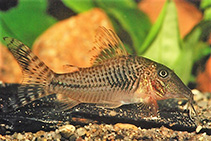| Family: |
Callichthyidae (Callichthyid armored catfishes), subfamily: Corydoradinae |
| Max. size: |
5.51 cm SL (male/unsexed) |
| Environment: |
demersal; freshwater |
| Distribution: |
South America: Peru. |
| Diagnosis: |
This species is distinguished from its congeners by the following characters: branch of the temporal sensory canal at sphenotic, this gives rise to the supraorbital canal, with two pores; upper tooth plate of branchial arch with three series of teeth; area at the corner of the mouth, ventral to the maxillary barbel, has a small fleshy flap; caudal-fin base with 2 moderate-sized dark-brown or black blotches on, one on its lateral portion and another one on its dorsal portion, blotches variably diffuse and/or fused with each other; no dark-brown or black stripe transversally crossing the orbit; with a longitudinal dark-brown or black stripe on the postdorsal region of flank midline, variably fused with the lateral peduncular blotch, and some specimens with slender, longitudinally elongated, dark-brown or black blotch on flank midline, forming a dash-like marking, stripe or dash-like blotch diffuse in some specimens; the region around dorsal-fin origin generally lacking a dark brown or black blotch, or displaying diffuse blotch (Ref. 124435). |
| Biology: |
Occurs in clear water streams; the substrate with fine white sand, gravel, sunken roots and wood as well as leaf litter. It occurs only in the open water bodies (Ref. 124435). |
| IUCN Red List Status: |
Not Evaluated (N.E.) Ref. (130435)
|
| Threat to humans: |
harmless |
Source and more info: www.fishbase.org. For personal, classroom, and other internal use only. Not for publication.

